The Tiny Fruit Fly Is a Giant of Scientific Research
Drosophila Melanogaster’s Place in Modern Science
The study of drosophila’s brain is a good example of the power of its “simple complexity” as a model organism — an animal that can teach school children about inheritance but also can be studied using incredible modern technology by brilliant researchers. Take its brain. Human brains weigh three pounds and have 100 billion neurons; the brains of the larval fruit flies Tracey studies can fit inside a cubic millimeter and have 10,000 neurons. And yet its neurons are not so unlike our own. “Yes, a fruit fly has fewer neurons than we do,” Tracey says. “It’s simpler in that way, but it’s still incredibly complex in its own way.”
This makes the advances made possible by the smaller scale of its brain — researchers have mapped 70 percent of its neurons using 3D modeling and electron microscopes, as opposed to almost none of the human brain — incredibly useful. Tracey’s work on studying pain pathways in the brain, and the way those pathways work using different classes of neurons, identified almost 40 genes related to pain tolerance. He hopes that at least one of those genes will help unlock the secrets of pain in the human brain.


Even as other animals gain ground as model organisms, the accessibility of the fruit fly’s biology remains incredibly relevant. For many years, the relative ease with which fruit fly genes could be mutated was a particular selling point for the species as a model organism. With the advent of CRISPR, mice and other higher mammals can be mutated using relatively precise techniques. “But CRISPR is not putting us out of business with fruit flies,” Tracey says. The fact remains that drosophila’s chromosomes are large enough to be easily examined, and that its individual neurons can be zoomed in on and examined using imaging technology and then manipulated to see how the fly reacts in real time.
“The mouse can be used to understand the specific details of how a particular mechanism or molecule works in a mammal,” Tracey says. “But in the fly, it’s just easier to discover new things.”
Important Drosophila Studies
The 2017 Nobel Prize was the crux of 30 years of research, beginning with the discovery of mutant flies whose biological clocks did not run on the usual 24-hour cycle, and ending with the molecular workings of the genetics of sleep.
Hermann Joseph Muller studied lethal mutations in fruit flies, and eventually showed that X-rays were lethally mutagenic. His research further led him to support concerns over the radiation danger of nuclear fallout.
Pain
In 2017, Dan Tracey and his fellow researchers uncovered upwards of 36 genes related to the tolerance of pain — in fruit flies called nociception, since pain is about perception, and no one has yet interviewed a fly about their response to being prodded by a hot poker.



Endpoints is a science publication by Elysium Health, a consumer health company translating advances in science and technology into effective, scientifically-sound health products. All stories on this site are meant for educational purposes — to encourage scientific literacy and improve the public perception of science.
